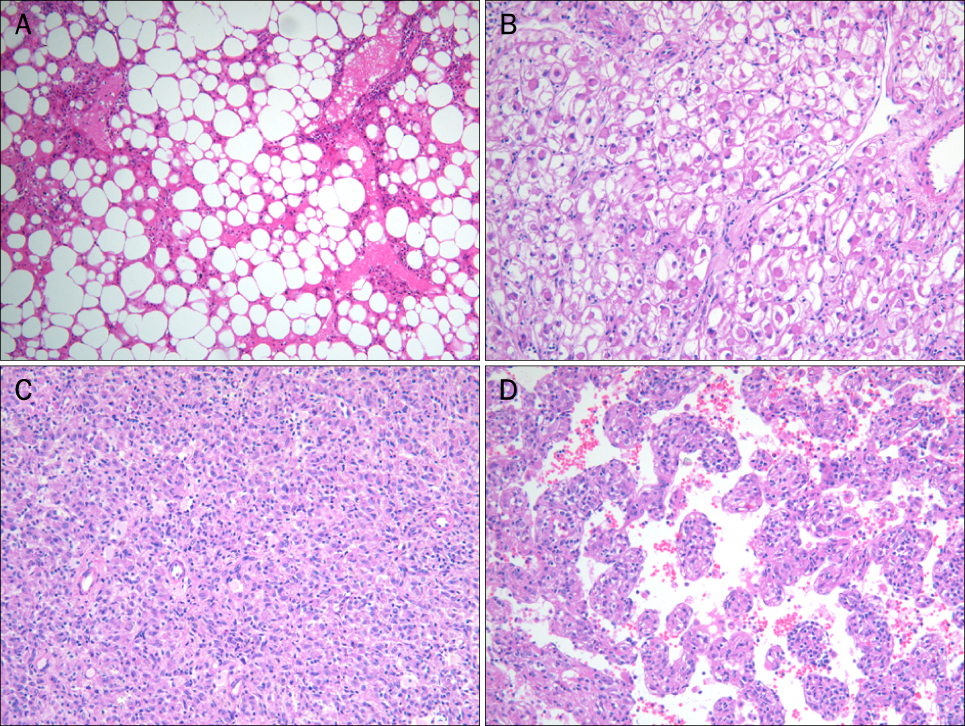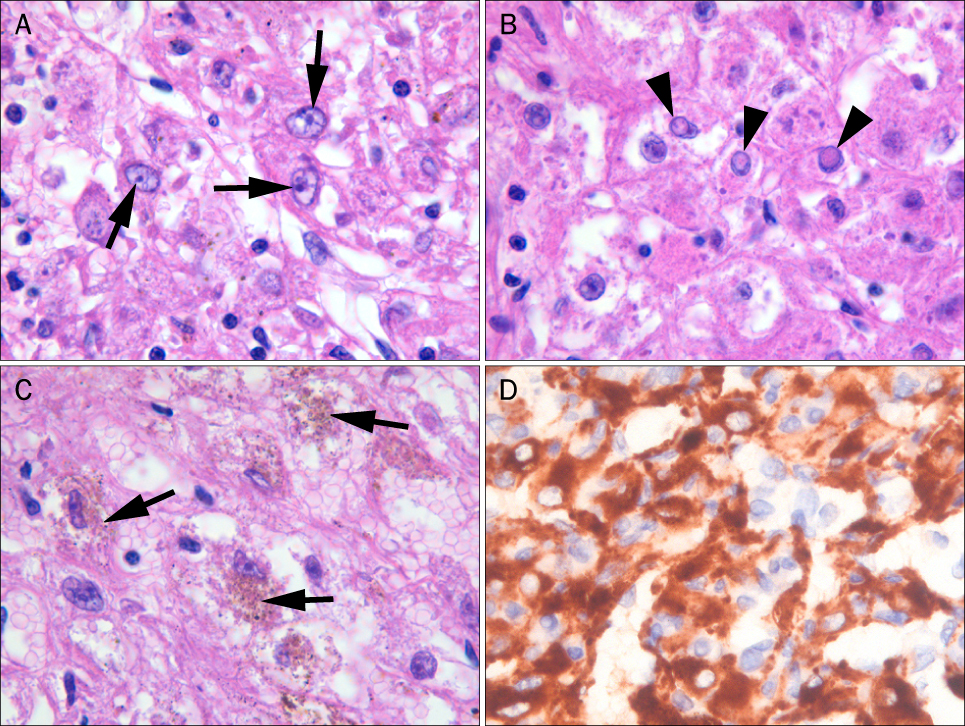Korean J Gastroenterol.
2012 Oct;60(4):242-248. 10.4166/kjg.2012.60.4.242.
Hepatic Angiomyolipoma with Variable Histologic Features: 8 Cases Resembling Hepatocellular Carcinoma or Inflammatory Pseudotumor
- Affiliations
-
- 1Department of Pathology, Keimyung University School of Medicine, Daegu, Korea.
- 2Department of Pathology, University of Ulsan College of Medicine, Asan Medical Center, Seoul, Korea. kjc@amc.seoul.kr
- KMID: 1775808
- DOI: http://doi.org/10.4166/kjg.2012.60.4.242
Abstract
- BACKGROUND/AIMS
Hepatic angiomyolipoma (AML) is a rare mesenchymal tumor of the liver and demonstrates a marked histologic diversity. HMB-45 is a promising immunomarker for this tumor and especially helpful to diagnosis of some AMLs with unusual morphology. The purpose of this study was to better define the variable histologic feature of hepatic AML.
METHODS
Eight hepatic AMLs were examined, and all of that were resection specimens. The diagnosis was confirmed by the presence of HMB-45 positive cells. Median age was 41.5 years old, and mean size of tumor was 8.94 cm.
RESULTS
Conventional mixed type was 5 cases which showed myomatous, angiomatous and lipomatous component, and 3 cases were myomatous predominant. Variable patterns including spider web cell morphology, solid sheet-like and trabecular pattern were identified on myomatous component and variable amount and patterns of inflammatory cell infiltration was identified.
CONCLUSIONS
With only histologic features, it is difficult to distinguish hepatic AML from other hepatic tumor including hepatocellular carcinoma or inflammatory pseudotumor. A correct diagnosis of hepatic AML is possible by a close histologic examination with immunohistochemical stainings such as HMB-45 which is important to patient's prognosis.
Keyword
MeSH Terms
Figure
Reference
-
1. Tsui WM, Colombari R, Portmann BC, et al. Hepatic angiomyolipoma: a clinicopathologic study of 30 cases and delineation of unusual morphologic variants. Am J Surg Pathol. 1999. 23:34–48.2. Takayama Y, Moriura S, Nagata J, et al. Hepatic angiomyolipoma: radiologic and histopathologic correlation. Abdom Imaging. 2002. 27:180–183.3. Dalle I, Sciot R, de Vos R, et al. Malignant angiomyolipoma of the liver: a hitherto unreported variant. Histopathology. 2000. 36:443–450.4. Nguyen TT, Gorman B, Shields D, Goodman Z. Malignant hepatic angiomyolipoma: report of a case and review of literature. Am J Surg Pathol. 2008. 32:793–798.5. Parfitt JR, Bella AJ, Izawa JI, Wehrli BM. Malignant neoplasm of perivascular epithelioid cells of the liver. Arch Pathol Lab Med. 2006. 130:1219–1222.6. Deng YF, Lin Q, Zhang SH, Ling YM, He JK, Chen XF. Malignant angiomyolipoma in the liver: a case report with pathological and molecular analysis. Pathol Res Pract. 2008. 204:911–918.7. Ohmori T, Arita N, Uraga N, et al. Giant hepatic angiomyolipoma. Histopathology. 1989. 15:540–543.8. Chung AY, Ng SB, Thng CH, Chow PK, Ooi LP. Hepatic angiomyolipoma mimicking hepatocellular carcinoma. Asian J Surg. 2002. 25:251–254.9. Kojima M, Nakamura S, Ohno Y, Sugihara S, Sakata N, Masawa N. Hepatic angiomyolipoma resembling an inflammatory pseudotumor of the liver. A case report. Pathol Res Pract. 2004. 200:713–716.10. Zhong DR, Ji XL. Hepatic angiomyolipoma-misdiagnosis as hepatocellular carcinoma: A report of 14 cases. World J Gastroenterol. 2000. 6:608–612.11. Pea M, Bonetti F, Zamboni G, et al. Melanocyte-marker-HMB-45 is regularly expressed in angiomyolipoma of the kidney. Pathology. 1991. 23:185–188.12. Tsui WM, Ng IO, Colombari R, Pea M. Hepatic angiomyolipomas. Histopathology. 1993. 22:602–603.13. Makhlouf HR, Ishak KG, Shekar R, Sesterhenn IA, Young DY, Fanburg-Smith JC. Melanoma markers in angiomyolipoma of the liver and kidney: a comparative study. Arch Pathol Lab Med. 2002. 126:49–55.14. Huang Z, He S, Xiao Z, Wu C, Li C, Chen X. Hepatic angiomyolipoma demonstrating similar imaging characteristics as hepatocellular carcinoma: one case report. J Huazhong Univ Sci Technolog Med Sci. 2005. 25:615–616.15. Sinn DH, Choi D, Choi MS, Park CK. A case of hepatic angiomyolipoma mimicking hepatocellular carcinoma. Korean J Gastroenterol. 2008. 51:1–3.16. Székely E, Schaff Z, Madaras L, Kupcsulik P, Zsirka A. Trabecular angiomyolipoma mimicking hepatic cell carcinoma. Pathol Oncol Res. 2000. 6:224–226.17. Chang KA, Yang DM, Kim HS, et al. Atypical hepatic angiomyolipoma: ct and mr findings: a case report. J Korean Radiol Soc. 2001. 45:381–384.18. Jung H, Won YS, Park IY, Cho HM, Chin HM, Kim JG. A case of hepatic angiomyolipoma. Korean J Hepatobiliary Pancreat Surg. 2004. 8:115–118.19. Lee DW, Hou D, Kim HO, Kim CW. Renal and hepatic angiomyolipoma and renal failure in two cases of tuberous sclerosis. Korean J Dermatol. 1992. 30:109–114.20. Lee YW, Chang JC, Byun WM, et al. Angiomyolipoma of the liver: a case report. J Korean Radiol Soc. 1993. 29:475–479.21. Park ER, Kim HR, Lee KA, et al. A case of hepatic angiomyolipoma diagnosed by fine-needle aspiration biopsy. Korean J Gastroenterol. 1999. 33:859–863.22. Park YN, Park C. Angiomyolipoma. Korean J Hepatol. 2001. 7:494–496.23. Yang JH, Park JW, Jang HJ, et al. A case of spontaneous rupture of hepatic angiomyolipoma. Korean J Med. 2004. 67:Suppl 3. S692–S696.24. Yim HL, Park KW, Lee KB. Multiple angiomyolipoma of the liver: report of a case with diagnosis by fine needle aspiration cytology. Korean J Cytopathol. 1998. 9:79–84.25. Kim AR, Kim HJ, Choi JH. Imprint cytology of hepatic angiomyolipoma: a case report. Korean J Cytopathol. 2008. 19:188–193.26. Lee JH, Kim JS. A case of hepatic angiomyolipoma showing different uptake on F-18 FDG and C-11 acetate PET. Nucl Med Mol Imaging. 2008. 42:246–248.27. Sinn DH, Choi D, Choi MS, Park CK. A case of hepatic angiomyolipoma mimicking hepatocellular carcinoma. Korean J Gastroenterol. 2008. 51:1–3.28. Jang SI, Park HS, Yu JW, et al. A case of angiomyolipoma of the liver. Korean J Med. 2010. 79:295–300.29. Lee WJ. Angiomyolipoma. Korean J Hepatol. 2008. 14:113–115.
- Full Text Links
- Actions
-
Cited
- CITED
-
- Close
- Share
- Similar articles
-
- Hepatic Angiomyolipoma Mimicking Primary Hepatocellular Carcinoma
- A Case of Hepatic Angiomyolipoma Showing Different Uptake on F-18 FDG and C-11 Acetate PET
- Inflammatory Pseudotumor of the Liver
- Two Cases of Hepatic Angiomyolipoma with Radiologic Similarity to Hepatocellular Carcinoma
- Hepatic Immunoglobulin G4-related Inflammatory Pseudotumor Mimicking Hepatocellular Carcinoma




